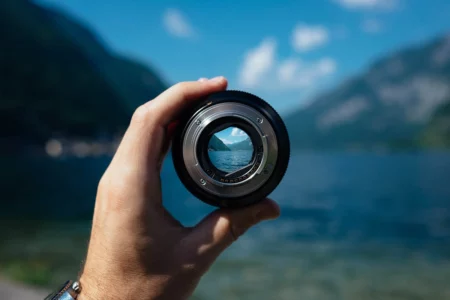Finding the correct white balance seemed impossible when I was a beginner photographer.
It’s a tough skill to master, and I just couldn’t get it right, even with the help of Adobe Photoshop and my professional DSLR camera.
But I was making some huge mistakes, just like most amateurs do.
Luckily, I had signed up to attend a local seminar, which was hosted by a very talented instructor.
He taught us some tricks that made an amazing difference in my professional life, and my work now reflects a more amazing touch.
You won’t believe how easy it is to learn.
Why Fix the White Balance?
So why do you want to fix the white balance?
Believe it or not, if the white in your photo is not a true white, then all the rest of the colors will be off.
It will affect the entire look of your picture.
But, if you can get it right, you can capture the brilliance of breathtaking sunrise, the glow of your daughter’s face as the sun shines on just the right spot, or even the pure beauty of a bride’s dream wedding gown.
But first, you have to learn to embrace the way that different light sources affect your photos.
Your results will change depending upon whether you are under a romantic candlelight, an overcast stormy sky, or a bright summer sun.
The light will change the way your subject appears, and your end result may have a funny color.
By preparing for color issues before they happen, you can produce beautiful and professional results.
1. Use a White, Gray, and Black Card
Did you know that experienced photographers have a trick up their sleeves?
They use special cards card to set the white balance on their cameras.
I was shocked when my instructor pulled out these cards and then edited his settings in Adobe PhotoShop.
All this time, I thought that photographers automatically knew how to capture the color correctly every single time.
(Don’t get me wrong—I know that there are extremely talented photographers who can do this—I am just not one of them!)
But I am unfortunately not as skilled as those lucky photographers, so I do rely on these wonderful magic cards.
These reference cards are ordered from a photo supply store and include a white card, a gray card, and a black card that are the exact color.
Then, every single time a photographer begins a photo shoot, they snap a shot of each individual card before they do anything else.
Personally, if I am taking individual shots of products that require a white background, I will include my reference cards in every single one of the shots.
This is a personal preference, but it makes it much faster to edit in PhotoShop.
After the photo shoot, the pictures of each of the cards are used to calibrate the settings in the photo editing software such as Adobe Photoshop or Elements.
By correcting the colors by matching them to the perfectly calibrated cards, you can ensure that your white balance will be exactly right every single time.
For best results, place the cards where you plan to your pictures, so you can try to catch the same light, shadows, and textures that your model will experience.
When taking a picture of cards, use the following procedures:
- Use your zoom lens to take a close-up shot of each card.
- Save the pictures and adjust the white balance.
- Shoot the remainder of your photos for your session in the RAW format.
- When you import your files into your software, open a file for each card and calibrate the colors in your software to match each one as follows:
- Click on gray, and set it to R=50, G=50, B=50
- Click on black, and set it to R=0, G=0, B=0
- Click on white, and set it to R=255, G=255, B=255.
- Repeat the process for every photo session, since your white balance will change in every situation.
2. Using Temperature
Temperature is another way that photographers use to correct white balance.
Personally, I find this method too tricky to master, but a lot of professionals find it much easier to use that the reference card method.
They often say that once you learn how to use the temperature method, you can easily shoot pictures under most conditions and never have to worry about carrying cards around.
It does make a lot of sense to me, but I just haven’t gotten the hang of it.
Many pictures tend to lean toward a blue or an orange overcast, but if you understand how Kelvin temperature works, use this to your advantage.
Visible light is formed by rays of different colors that can actually be translated into a specific temperature that is measured in Kelvin (K).
Our human eyes automatically adjust the color temperatures of these different temperatures of light and translate them into the colors that we see.
For example, if you imagine the following list ranging from the color orange to the color blue, the cooler temperatures are orange, and the hotter temperatures are blue.
• Orange
• Candlelight – 1000 – 2000 K
• Lightbulbs – 3500K
• Fluorescent Light – 4000 K
• Daylight – 5000 K
• Cloudy – 6500 K
• Shade – 7000 K – 9000 K
• Blue Sky – 10000 K
• Blue
When you use Kelvin to help you find the white balance, you need to change the settings on your camera equipment.
Go into the settings in your camera and make sure that they are set to “Kelvin”.
Most modern cameras allow you to set the light temperature to achieve the perfect white balance.
If you can’t find one option on your camera, adjust the color temperature manually to get the best results.
With some practice, you will learn to set up white balance quickly.
When editing your pictures, open your file in Adobe Photoshop and adjust the temperature of your photo.
You want to try to match the temperature of your file to match the environment in which you took the pictures.
Most will be at 5000 K on the low end and 7500 K on the high end.
3. Your Camera’s Automatic Setting
Most people who are learning stock photographers are not ready to invest money in white, black, and gray reference cards, and they aren’t interested in spending the time to learn the temperature system.
If you fall into either of these categories, and you don’t know how to correct the white balance, then you probably will be better off relying on your camera’s automatic settings.
The joke in my house is that these are Ph.D. cameras (“Push Here Dummy”).
And for a long time, that certainly was the case for me. I took the “Push Here Dummy” school of thought to a whole new level and I stuck with a few buttons.
But sometimes you need to step outside the box. So start with this, and gain some confidence. Pay attention to the “before” and the “after”.
Ask yourself, “What did the image look like before the changes were made?” and “What did PhotoShop change in the image?”
After a while, you will begin to notice that the “after” image might look a little bluer, or something else.
You will begin to pick up on these things and learn them yourself.
In the meantime, however, if you are uncomfortable working using the methods above, use your professional DSLR to automatically set the white balance.
Most modern point-and-shoot cameras come with features that automatically figure out the best white balance options by adjusting the color ratios.
In most cases, they will work just fine, but you may run into trouble every once in a while.
Sometimes you will notice that they will overcorrect and they might ruin a very nice picture and destroy the beautiful color.
For example, if you are taking a picture of an amazing sunset, the camera might think that the images should not have so much orange or pink in them.
The camera will try to tone down those colors because it thinks that it is doing its job.
After a while, you may start to become disappointed with the results of the automatic settings.
But that is a good thing!
That means that you are developing as a photographer! (Get it?)
That’s when you are ready to start exploring some of the methods above.
Your user’s manual should have complete instructions on how to use these settings on your camera.
If you have lost your manual, you can probably find it online.
Or, many other people have created helpful sites that might teach you how to do it. Good luck!
4. Using Software
As with every stock photo that you take, you want to try to get the pictures correct when you actually take the shot. Why?
Because if you can capture the image perfectly when you take the picture, then the image will be of the highest quality with the least imperfections.
If you can master white balancing on your camera, it is the best way to achieve the correct light temperature.
However, if the RAW files don’t look correct when you open them, you can always correct them in the post-processing stage.
I always use Adobe Photoshop when I am working on my photos.
I have used it for a long time, and it works amazingly well.
I have that monthly subscription plan, but I only have PhotoShop on it; I don’t have any of the other programs.
You can do so much with this program, and fixing white balance is so easy!
Keep in mind that post-processing adjustments can be costly in terms of pixels.
Making any changes in Photoshop will change the quality of the original photo since it changes the pixels in the original photographs.
This is why professionals spend more time focusing on getting the right exposure in the first place instead of editing later.
Conclusion
Setting the correct white balance is very important in increasing your photography skills.
This not only saves enormous editing time in Adobe Photoshop, but the perfection that a well-balanced image delivers is hard to achieve with editing if you are not an experienced photo editor.
The good news is that learning how to get the perfect white balance is very easy.
These are the essential steps to achieve the proper white balance with your photographs. For more photo tips, see our other articles.


